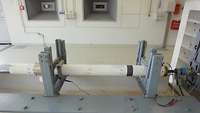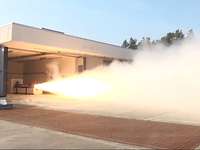



Andrea Moss has been working with the Bundeswehr Technical Center for Weapons and Ammunition (WTDWehrtechnische Dienststelle 91) in Meppen for 34 years. She examines and tests the burning characteristics of solid rocket propulsion systems.
After completing her studies in mechanical engineering and the technical service career training for civil servants of the higher intermediate-level, Andrea Moss made her dream come true: In 1987, she started a career at WTDWehrtechnische Dienststelle 91 in Meppen. As a test manager, she was responsible for testing the MARSMittleres Artillerieraketensystem rocket launcher system. Then she worked as an administrative specialist and was in charge of the examination of rocket and guided-missile fuzes. Today, the civil servant is the chief of section for rocket propulsion systems in the area of “rocket propulsion systems and gun propellants”. As a test manager, she executes and evaluates what is called the stationary burning of rocket propulsion systems at different test stands together with her team.
Ms. Moss, your work sounds highly explosive. Are there any special requirements for the handling of live ammunition?
Yes, there are! In our agency, there is one qualification of particular importance that goes beyond career training: proficiency in the handling of ammunition. It is similar to the training of the explosive ordnance disposal specialists of the armed forces. However, the focus lies on testing and modifying ammunition and on assessing blind shells and stressed ammunition. During my work as part of the WTDWehrtechnische Dienststelle 91 teaching staff, I could make perfect use of this knowledge. For many years, I trained people from the entire armaments organization and from other agencies, such as the German Federal Office of Criminal Investigation and the explosive ordnance disposal teams of the different German states, in ammunition handling.
What does your everyday workday look like?
It depends. Let’s take an example: Before a test, our branch gets an order to conduct an examination. This is also the signal for me to start planning the test. I have to consider the details of the test procedure. But there are also other important things to think about: What do we need for the test setup? Do our WTDWehrtechnische Dienststelle workshops have to prepare anything? And - last but not least: Which measuring technology will we use?
Apart from that, I have to consider what can happen if the procedure doesn’t go as planned. What will happen if, for example, the rocket motor doesn’t ignite or if it unexpectedly disintegrates, or in other words: bursts? Could this be dangerous? And: Which measures have to be taken into account during the preparatory phase? Sometimes, it really is a challenge!
Of course, all the planning must be put on paper too. Apart from the documentation and evaluation of the tests, I have to study technical documents to know all about the ammunition. Moreover, all departments involved within our agency but also with BAAINBwBundesamt für Ausrüstung, Informationstechnik und Nutzung der Bundeswehr and other Bundeswehr Technical Centers and companies must be coordinated.
What are you currently working on?
Within the scope of an accident investigation, I am currently preparing the burning of a damaged rocket motor. Due to the nature of the defect, we expect the motor to burst when burning. This would considerably affect our test stand. Therefore, the test will be set up in a special protective bunker. All necessary installations such as the test stand on which we will secure the motor, the protective walls and the measuring technology have to be set up in the bunker. The preparations for this test involve quite a lot of effort.
And what exactly is the procedure of such a test?
The actual test starts with ensuring the safety of the danger areas and preparing the ammunition. For instance, we mount pressure transmitters and connect the cables for the measuring instruments. Afterwards, we secure the rocket motor on the test stand with lashing chains. When all other work is done and everyone is safe, the fuze of the rocket motor is electrically connected. After closing the safety doors and, in case of larger rocket motors, the window shutters, everything is ready for the burning. We check the monitoring devices and the recording devices for measuring, of course, one last time. Only then, the ignition current is connected and the motor is burnt. The burning, however, will only take a few seconds. Once the cloud of exhaust gas has dissolved, we can enter the danger area and examine the components.
Depending on the order, the case of the rocket motor has to then undergo a static bursting pressure test as well. We seal the case and fill it with water. Afterwards, the case is pressurized until it bursts.

The rocket motor is mounted on the test stand and the necessary technical equipment ist installed…
Bundeswehr/WTD91
... before the rocket motor burns in a few seconds.
Bundeswehr/WTD91What can you learn from these measurement results?
The most important point of the examination is the assessment of the safety and operational reliability of the rocket propulsion systems. Of course, they have to fulfill the operational requirements, the storing requirements, and the requirements for handling and transport throughout their service lives. Apart from that, the burst pressure test provides important information on the design of the rocket motor.
What has been your most exciting experience so far?
The accident investigation I have already mentioned is, of course, very interesting. But I also remember my work in the fuze lab in the 1990s when I examined fuzes from the stocks of the military of former East Germany, the National People’s Army (NVANationale Volksarmee). There was hardly any documentation available about this ammunition. We literally had to disassemble and empty the armed fuzes to the “last screw”, which was extremely challenging. We then documented the findings in technical drawings, wiring diagrams and functional descriptions. At that time, these findings about the state of the art of the Soviet Union and the Warsaw Pact were of great importance.
Given the chance, whom would you like to meet in person?
I would love to have met the physicist Marie Curie in person. I admire her determination and assertiveness, especially considering the circumstances in which she had to study and work.